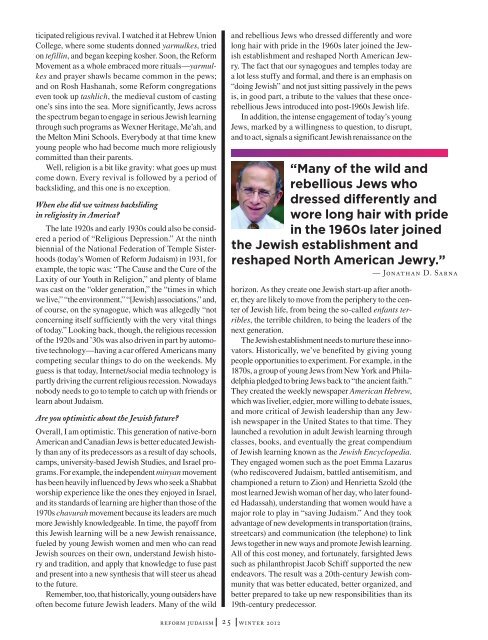reform judaism - UAHC
reform judaism - UAHC
reform judaism - UAHC
- No tags were found...
You also want an ePaper? Increase the reach of your titles
YUMPU automatically turns print PDFs into web optimized ePapers that Google loves.
ticipated religious revival. I watched it at Hebrew UnionCollege, where some students donned yarmulkes, triedon tefillin, and began keeping kosher. Soon, the ReformMovement as a whole embraced more rituals—yarmulkesand prayer shawls became common in the pews;and on Rosh Hashanah, some Reform congregationseven took up tashlich, the medieval custom of castingone’s sins into the sea. More significantly, Jews acrossthe spectrum began to engage in serious Jewish learningthrough such programs as Wexner Heritage, Me’ah, andthe Melton Mini Schools. Everybody at that time knewyoung people who had become much more religiouslycommitted than their parents.Well, religion is a bit like gravity: what goes up mustcome down. Every revival is followed by a period ofbacksliding, and this one is no exception.When else did we witness backslidingin religiosity in America?The late 1920s and early 1930s could also be considereda period of “Religious Depression.” At the ninthbiennial of the National Federation of Temple Sisterhoods(today’s Women of Reform Judaism) in 1931, forexample, the topic was: “The Cause and the Cure of theLaxity of our Youth in Religion,” and plenty of blamewas cast on the “older generation,” the “times in whichwe live,” “the environment,” “[Jewish] associations,” and,of course, on the synagogue, which was allegedly “notconcerning itself sufficiently with the very vital thingsof today.” Looking back, though, the religious recessionof the 1920s and ’30s was also driven in part by automotivetechnology—having a car offered Americans manycompeting secular things to do on the weekends. Myguess is that today, Internet/social media technology ispartly driving the current religious recession. Nowadaysnobody needs to go to temple to catch up with friends orlearn about Judaism.Are you optimistic about the Jewish future?Overall, I am optimistic. This generation of native-bornAmerican and Canadian Jews is better educated Jewishlythan any of its predecessors as a result of day schools,camps, university-based Jewish Studies, and Israel programs.For example, the independent minyan movementhas been heavily influenced by Jews who seek a Shabbatworship experience like the ones they enjoyed in Israel,and its standards of learning are higher than those of the1970s chavurah movement because its leaders are muchmore Jewishly knowledgeable. In time, the payoff fromthis Jewish learning will be a new Jewish renaissance,fueled by young Jewish women and men who can readJewish sources on their own, understand Jewish historyand tradition, and apply that knowledge to fuse pastand present into a new synthesis that will steer us aheadto the future.Remember, too, that historically, young outsiders haveoften become future Jewish leaders. Many of the wildand rebellious Jews who dressed differently and worelong hair with pride in the 1960s later joined the Jewishestablishment and reshaped North American Jewry.The fact that our synagogues and temples today area lot less stuffy and formal, and there is an emphasis on“doing Jewish” and not just sitting passively in the pewsis, in good part, a tribute to the values that these oncerebelliousJews introduced into post-1960s Jewish life.In addition, the intense engagement of today’s youngJews, marked by a willingness to question, to disrupt,and to act, signals a significant Jewish renaissance on the“Many of the wild andrebellious Jews whodressed differently andwore long hair with pridein the 1960s later joinedthe Jewish establishment andreshaped North American Jewry.”— Jonathan D. Sarnahorizon. As they create one Jewish start-up after another,they are likely to move from the periphery to the centerof Jewish life, from being the so-called enfants terribles,the terrible children, to being the leaders of thenext generation.The Jewish establishment needs to nurture these innovators.Historically, we’ve benefited by giving youngpeople opportunities to experiment. For example, in the1870s, a group of young Jews from New York and Philadelphiapledged to bring Jews back to “the ancient faith.”They created the weekly newspaper American Hebrew,which was livelier, edgier, more willing to debate issues,and more critical of Jewish leadership than any Jewishnewspaper in the United States to that time. Theylaunched a revolution in adult Jewish learning throughclasses, books, and eventually the great compendiumof Jewish learning known as the Jewish Encyclopedia.They engaged women such as the poet Emma Lazarus(who rediscovered Judaism, battled antisemitism, andchampioned a return to Zion) and Henrietta Szold (themost learned Jewish woman of her day, who later foundedHadassah), understanding that women would have amajor role to play in “saving Judaism.” And they tookadvantage of new developments in transportation (trains,streetcars) and communication (the telephone) to linkJews together in new ways and promote Jewish learning.All of this cost money, and fortunately, farsighted Jewssuch as philanthropist Jacob Schiff supported the newendeavors. The result was a 20th-century Jewish communitythat was better educated, better organized, andbetter prepared to take up new responsibilities than its19th-century predecessor.<strong>reform</strong> <strong>judaism</strong> 25 winter 2012


